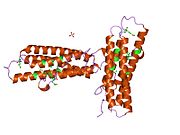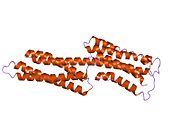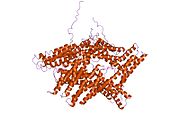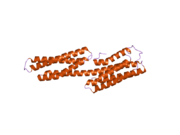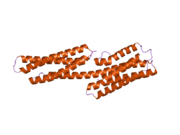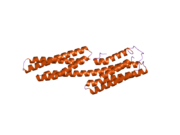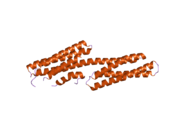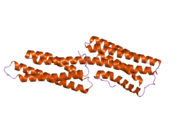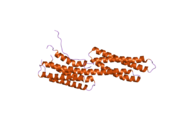Vinculin
Ensembl | |||||||||
|---|---|---|---|---|---|---|---|---|---|
| UniProt | |||||||||
| RefSeq (mRNA) | |||||||||
| RefSeq (protein) | |||||||||
| Location (UCSC) | Chr 10: 74 – 74.12 Mb | Chr 14: 20.98 – 21.08 Mb | |||||||
| PubMed search | [3] | [4] | |||||||
| View/Edit Human | View/Edit Mouse |

In mammalian cells, vinculin is a membrane-cytoskeletal protein in
Discovered independently by Benny Geiger[5] and Keith Burridge,[6] its sequence is 20%–30% similar to α-catenin, which serves a similar function.
Binding alternately to talin or α-actinin, vinculin's shape and, as a consequence, its binding properties are changed. The vinculin gene occurs as a single copy and what appears to be no close relative to take over functions in its absence. Its splice variant metavinculin (see below) also needs vinculin to heterodimerize and work in a dependent fashion.
Structure
Vinculin is a 117-kDa cytoskeletal protein with 1066
Essentially, there is an 835 amino acid N-terminal head, which is split into four domains. This is linked to the C-terminal tail with a linker region.
The recent discovery of the 3D structure sheds light on how this protein tailors its shape to perform a variety of functions. For example, vinculin is able to control the cell's motility by simply altering its shape from active to inactive. When in its ‘inactive’ state, vinculin's conformation is characterized by the interaction between its head and tail domains. And, when transforming to the ‘active’ form, such as when talin triggers binding, the intramolecular interaction between the tail and head is severed. In other words, when talin's binding sites (VBS) of α-helices bind to a helical bundle structure in vinculin's head domain, the ‘helical bundle conversion’ is initiated, which leads to the reorganization of the α-helices (α1- α-4), resulting in an entirely new five-helical bundle structure. This function also extends to cancer cells, and regulating their movement and proliferation of cancer to other parts of the body.
Mechanism and function
Cell spreading and movement occur through the process of binding of cell surface
The complex at the focal adhesions consists of several proteins such as vinculin, α-actinin, paxillin, and talin, at the intracellular face of the plasma membrane.In more specific terms, the amino-terminus of vinculin binds to talin, which, in turn, binds to β-integrins, and the carboxy-terminus binds to actin, phospholipids, and paxillin-forming homodimers. The binding of vinculin to talin and actin is regulated by polyphosphoinositides and inhibited by acidic phospholipids. The complex then serves to anchor actin filaments to the membrane and thus, helps to reinforce force on talin within the focal adhesions.[9]
The loss of vinculin impacts a variety of cell functions; it disrupts the formation of the complex, and prevents cell adhesion and spreading. The absence of the protein demonstrates a decrease in spreading of cells, accompanied by reduced stress fiber formation, formation of fewer focal adhesions, and inhibition of
Activation
Vinculin is present in equilibrium between an active and inactive state.
Binding site
| VBS | |||||||||
|---|---|---|---|---|---|---|---|---|---|
 human vinculin head (1-258) in complex with talin's vinculin binding site 3 (residues 1944-1969) | |||||||||
| Identifiers | |||||||||
| Symbol | VBS | ||||||||
| Pfam | PF08913 | ||||||||
| InterPro | IPR015009 | ||||||||
| |||||||||
Vinculin
Splice variants
The length of the insert in metavinculin is 68 AA in mammals and 79 in frog. Metavinculin tail domain has a lower affinity for the head as compared with the vinculin tail. In case of metavinculin, unfurling of the C-terminal hydrophobic hairpin loop of tail domain is impaired by the negative charges of the 68-amino acid insert, thus requiring phospholipid-activated regular isoform of vinculin to fully activate the metavinculin molecule.
Interactions
Vinculin has been shown to
In cases of Small Intestinal Bacterial Overgrowth presented as IBS symptoms, anti-CdtB antibodies have been identified to affect vinculin function, which is required in gut motility.[22]
References
- ^ a b c GRCh38: Ensembl release 89: ENSG00000035403 – Ensembl, May 2017
- ^ a b c GRCm38: Ensembl release 89: ENSMUSG00000021823 – Ensembl, May 2017
- ^ "Human PubMed Reference:". National Center for Biotechnology Information, U.S. National Library of Medicine.
- ^ "Mouse PubMed Reference:". National Center for Biotechnology Information, U.S. National Library of Medicine.
- S2CID 33153559.
- S2CID 43087259.
- ^ PMID 11785963.
- PMID 9486805.
- ^ PMID 9056408.
- ^ PMID 15242595.
- PMID 16460027.
- PMID 6809764.
- PMID 15159399.
- S2CID 39567003.
- PMID 3138246.
- PMID 9405455.
- PMID 9535896.
- PMID 10330411.
- PMID 9054445.
- PMID 8922390.
- PMID 10085297.
- S2CID 22408999.
Further reading
- Critchley DR (November 2004). "Cytoskeletal proteins talin and vinculin in integrin-mediated adhesion". Biochemical Society Transactions. 32 (Pt 5): 831–6. PMID 15494027.
- Koteliansky VE, Ogryzko EP, Zhidkova NI, Weller PA, Critchley DR, Vancompernolle K, Vandekerckhove J, Strasser P, Way M, Gimona M (March 1992). "An additional exon in the human vinculin gene specifically encodes meta-vinculin-specific difference peptide. Cross-species comparison reveals variable and conserved motifs in the meta-vinculin insert". European Journal of Biochemistry. 204 (2): 767–72. PMID 1339348.
- Mulligan LM, Gardner E, Telenius H, Ponder BA (August 1992). "Complementary physical and genetic techniques map the vinculin (VCL) gene on chromosome 10q". Genomics. 13 (4): 1347–9. PMID 1505973.
- Weller PA, Ogryzko EP, Corben EB, Zhidkova NI, Patel B, Price GJ, Spurr NK, Koteliansky VE, Critchley DR (August 1990). "Complete sequence of human vinculin and assignment of the gene to chromosome 10". Proceedings of the National Academy of Sciences of the United States of America. 87 (15): 5667–71. PMID 2116004.
- Turner CE, Burridge K (June 1989). "Detection of metavinculin in human platelets using a modified talin overlay assay". European Journal of Cell Biology. 49 (1): 202–6. PMID 2503380.
- Turner CE, Miller JT (June 1994). "Primary sequence of paxillin contains putative SH2 and SH3 domain binding motifs and multiple LIM domains: identification of a vinculin and pp125Fak-binding region". Journal of Cell Science. 107 ( Pt 6) (6): 1583–91. PMID 7525621.
- Salgia R, Li JL, Lo SH, Brunkhorst B, Kansas GS, Sobhany ES, Sun Y, Pisick E, Hallek M, Ernst T (March 1995). "Molecular cloning of human paxillin, a focal adhesion protein phosphorylated by P210BCR/ABL". The Journal of Biological Chemistry. 270 (10): 5039–47. PMID 7534286.
- Adams MD, Kerlavage AR, Fleischmann RD, Fuldner RA, Bult CJ, Lee NH, Kirkness EF, Weinstock KG, Gocayne JD, White O (September 1995). "Initial assessment of human gene diversity and expression patterns based upon 83 million nucleotides of cDNA sequence" (PDF). Nature. 377 (6547 Suppl): 3–174. PMID 7566098.
- Hagmann J (April 1993). "Pattern formation and handedness in the cytoskeleton of human platelets". Proceedings of the National Academy of Sciences of the United States of America. 90 (8): 3280–3. PMID 7682697.
- Johnson RP, Craig SW (January 1995). "F-actin binding site masked by the intramolecular association of vinculin head and tail domains". Nature. 373 (6511): 261–4. S2CID 4369795.
- Hirsch MS, Law LY, Trinkaus-Randall V, Svoboda KK (1995). "The intracellular distribution of vinculin and alpha 2 integrin in epithelial cells and chondrocytes". Scanning. 16 (5): 275–84. PMID 7994488.
- Fausser JL, Ungewickell E, Ruch JV, Lesot H (October 1993). "Interaction of vinculin with the clathrin heavy chain". Journal of Biochemistry. 114 (4): 498–503. PMID 8276759.
- Moiseyeva EP, Weller PA, Zhidkova NI, Corben EB, Patel B, Jasinska I, Koteliansky VE, Critchley DR (February 1993). "Organization of the human gene encoding the cytoskeletal protein vinculin and the sequence of the vinculin promoter". The Journal of Biological Chemistry. 268 (6): 4318–25. PMID 8440716.
- Yoshida M, Westlin WF, Wang N, Ingber DE, Rosenzweig A, Resnick N, Gimbrone MA (April 1996). "Leukocyte adhesion to vascular endothelium induces E-selectin linkage to the actin cytoskeleton". The Journal of Cell Biology. 133 (2): 445–55. PMID 8609175.
- Scott GA, Liang H, Cassidy LL (August 1995). "Developmental regulation of focal contact protein expression in human melanocytes". Pigment Cell Research. 8 (4): 221–8. PMID 8610074.
- Deroanne CF, Colige AC, Nusgens BV, Lapiere CM (May 1996). "Modulation of expression and assembly of vinculin during in vitro fibrillar collagen-induced angiogenesis and its reversal". Experimental Cell Research. 224 (2): 215–23. PMID 8612698.
- Maeda M, Holder E, Lowes B, Valent S, Bies RD (January 1997). "Dilated cardiomyopathy associated with deficiency of the cytoskeletal protein metavinculin". Circulation. 95 (1): 17–20. PMID 8994410.
- Mazaki Y, Hashimoto S, Sabe H (March 1997). "Monocyte cells and cancer cells express novel paxillin isoforms with different binding properties to focal adhesion proteins". The Journal of Biological Chemistry. 272 (11): 7437–44. PMID 9054445.
- Hazan RB, Kang L, Roe S, Borgen PI, Rimm DL (December 1997). "Vinculin is associated with the E-cadherin adhesion complex". The Journal of Biological Chemistry. 272 (51): 32448–53. PMID 9405455.
- Hazan RB, Norton L (April 1998). "The epidermal growth factor receptor modulates the interaction of E-cadherin with the actin cytoskeleton". The Journal of Biological Chemistry. 273 (15): 9078–84. PMID 9535896.

